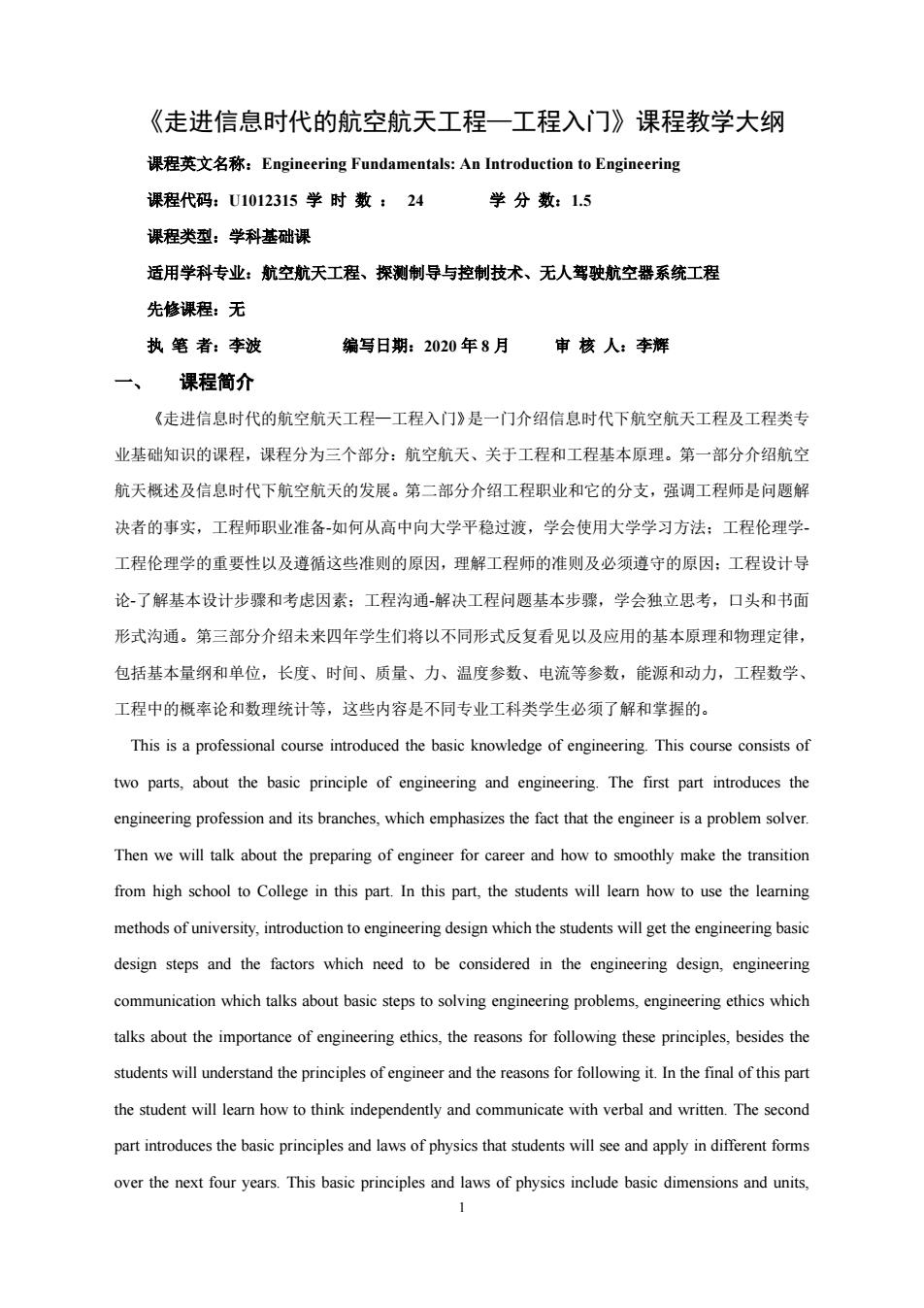
《走进信息时代的航空航天工程一工程入门》课程教学大纲 课程英文名称:Engineering Fundamentals:An Introduction to Engineering 课程代码:U1012315学时数:24 学分数:1.5 课程类型:学科基础课 适用学科专业:航空航天工程、探测制导与控制技术、无人驾驶航空器系统工程 先修课程:无 执笔者:李波 编写日期:2020年8月 审核人:李辉 一、 课程简介 《走进信息时代的航空航天工程一工程入门》是一门介绍信息时代下航空航天工程及工程类专 业基础知识的课程,课程分为三个部分:航空航天、关于工程和工程基本原理。第一部分介绍航空 航天概述及信息时代下航空航天的发展。第二部分介绍工程职业和它的分支,强调工程师是问题解 决者的事实,工程师职业准备-如何从高中向大学平稳过渡,学会使用大学学习方法:工程伦理学 工程伦理学的重要性以及遵循这些准则的原因,理解工程师的准则及必须遵守的原因:工程设计导 论了解基本设计步骤和考虑因素:工程沟通解决工程问题基本步骤,学会独立思考,口头和书面 形式沟通。第三部分介绍未来四年学生们将以不同形式反复看见以及应用的基本原理和物理定律, 包括基本量纲和单位,长度、时间、质量、力、温度参数、电流等参数,能源和动力,工程数学、 工程中的概率论和数理统计等,这些内容是不同专业工科类学生必须了解和掌握的。 This is a professional course introduced the basic knowledge of engineering.This course consists of two parts,about the basic principle of engineering and engineering.The first part introduces the engineering profession and its branches,which emphasizes the fact that the engineer is a problem solver. Then we will talk about the preparing of engineer for career and how to smoothly make the transition from high school to College in this part.In this part,the students will learn how to use the learning methods of university,introduction to engineering design which the students will get the engineering basic design steps and the factors which need to be considered in the engineering design,engineering communication which talks about basic steps to solving engineering problems,engineering ethics which talks about the importance of engineering ethics,the reasons for following these principles,besides the students will understand the principles of engineer and the reasons for following it.In the final of this part the student will learn how to think independently and communicate with verbal and written.The second part introduces the basic principles and laws of physics that students will see and apply in different forms over the next four years.This basic principles and laws of physics include basic dimensions and units
1 《走进信息时代的航空航天工程—工程入门》课程教学大纲 课程英文名称:Engineering Fundamentals: An Introduction to Engineering 课程代码:U1012315 学 时 数 : 24 学 分 数:1.5 课程类型:学科基础课 适用学科专业:航空航天工程、探测制导与控制技术、无人驾驶航空器系统工程 先修课程:无 执 笔 者:李波 编写日期:2020 年 8 月 审 核 人:李辉 一、 课程简介 《走进信息时代的航空航天工程—工程入门》是一门介绍信息时代下航空航天工程及工程类专 业基础知识的课程,课程分为三个部分:航空航天、关于工程和工程基本原理。第一部分介绍航空 航天概述及信息时代下航空航天的发展。第二部分介绍工程职业和它的分支,强调工程师是问题解 决者的事实,工程师职业准备-如何从高中向大学平稳过渡,学会使用大学学习方法;工程伦理学- 工程伦理学的重要性以及遵循这些准则的原因,理解工程师的准则及必须遵守的原因;工程设计导 论-了解基本设计步骤和考虑因素;工程沟通-解决工程问题基本步骤,学会独立思考,口头和书面 形式沟通。第三部分介绍未来四年学生们将以不同形式反复看见以及应用的基本原理和物理定律, 包括基本量纲和单位,长度、时间、质量、力、温度参数、电流等参数,能源和动力,工程数学、 工程中的概率论和数理统计等,这些内容是不同专业工科类学生必须了解和掌握的。 This is a professional course introduced the basic knowledge of engineering. This course consists of two parts, about the basic principle of engineering and engineering. The first part introduces the engineering profession and its branches, which emphasizes the fact that the engineer is a problem solver. Then we will talk about the preparing of engineer for career and how to smoothly make the transition from high school to College in this part. In this part, the students will learn how to use the learning methods of university, introduction to engineering design which the students will get the engineering basic design steps and the factors which need to be considered in the engineering design, engineering communication which talks about basic steps to solving engineering problems, engineering ethics which talks about the importance of engineering ethics, the reasons for following these principles, besides the students will understand the principles of engineer and the reasons for following it. In the final of this part the student will learn how to think independently and communicate with verbal and written. The second part introduces the basic principles and laws of physics that students will see and apply in different forms over the next four years. This basic principles and laws of physics include basic dimensions and units
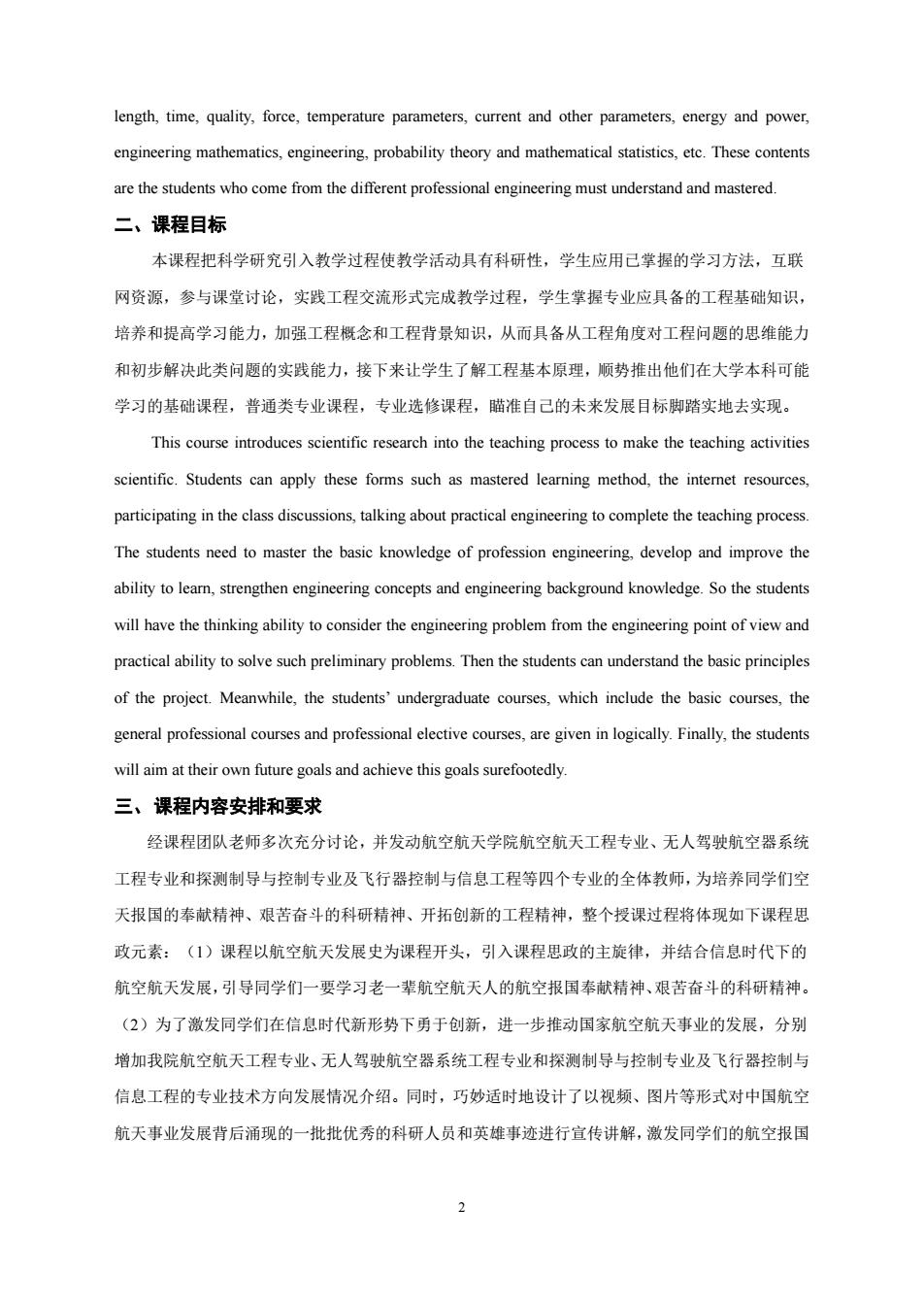
length,time,quality,force,temperature parameters,current and other parameters,energy and power, engineering mathematics,engineering,probability theory and mathematical statistics,etc.These contents are the students who come from the different professional engineering must understand and mastered. 二、课程目标 本课程把科学研究引入教学过程使教学活动具有科研性,学生应用己掌握的学习方法,互联 网资源,参与课堂讨论,实践工程交流形式完成教学过程,学生掌握专业应具备的工程基础知识, 培养和提高学习能力,加强工程概念和工程背景知识,从而具备从工程角度对工程问题的思维能力 和初步解决此类问题的实践能力,接下来让学生了解工程基本原理,顺势推出他们在大学本科可能 学习的基础课程,普通类专业课程,专业选修课程,瞄准自己的未来发展目标脚踏实地去实现。 This course introduces scientific research into the teaching process to make the teaching activities scientific.Students can apply these forms such as mastered learning method,the internet resources, participating in the class discussions,talking about practical engineering to complete the teaching process. The students need to master the basic knowledge of profession engineering,develop and improve the ability to learn,strengthen engineering concepts and engineering background knowledge.So the students will have the thinking ability to consider the engineering problem from the engineering point of view and practical ability to solve such preliminary problems.Then the students can understand the basic principles of the project.Meanwhile,the students'undergraduate courses,which include the basic courses,the general professional courses and professional elective courses,are given in logically.Finally,the students will aim at their own future goals and achieve this goals surefootedly. 三、课程内容安排和要求 经课程团队老师多次充分讨论,并发动航空航天学院航空航天工程专业、无人驾驶航空器系统 工程专业和探测制导与控制专业及飞行器控制与信息工程等四个专业的全体教师,为培养同学们空 天报国的奉献精神、艰苦奋斗的科研精神、开拓创新的工程精神,整个授课过程将体现如下课程思 政元素:(1)课程以航空航天发展史为课程开头,引入课程思政的主旋律,并结合信息时代下的 航空航天发展,引导同学们一要学习老一辈航空航天人的航空报国奉献精神、艰苦奋斗的科研精神。 (2)为了激发同学们在信息时代新形势下勇于创新,进一步推动国家航空航天事业的发展,分别 增加我院航空航天工程专业、无人驾驶航空器系统工程专业和探测制导与控制专业及飞行器控制与 信息工程的专业技术方向发展情况介绍。同时,巧妙适时地设计了以视频、图片等形式对中国航空 航天事业发展背后涌现的一批批优秀的科研人员和英雄事迹进行宣传讲解,激发同学们的航空报国 2
2 length, time, quality, force, temperature parameters, current and other parameters, energy and power, engineering mathematics, engineering, probability theory and mathematical statistics, etc. These contents are the students who come from the different professional engineering must understand and mastered. 二、课程目标 本课程把科学研究引入教学过程使教学活动具有科研性,学生应用已掌握的学习方法,互联 网资源,参与课堂讨论,实践工程交流形式完成教学过程,学生掌握专业应具备的工程基础知识, 培养和提高学习能力,加强工程概念和工程背景知识,从而具备从工程角度对工程问题的思维能力 和初步解决此类问题的实践能力,接下来让学生了解工程基本原理,顺势推出他们在大学本科可能 学习的基础课程,普通类专业课程,专业选修课程,瞄准自己的未来发展目标脚踏实地去实现。 This course introduces scientific research into the teaching process to make the teaching activities scientific. Students can apply these forms such as mastered learning method, the internet resources, participating in the class discussions, talking about practical engineering to complete the teaching process. The students need to master the basic knowledge of profession engineering, develop and improve the ability to learn, strengthen engineering concepts and engineering background knowledge. So the students will have the thinking ability to consider the engineering problem from the engineering point of view and practical ability to solve such preliminary problems. Then the students can understand the basic principles of the project. Meanwhile, the students’ undergraduate courses, which include the basic courses, the general professional courses and professional elective courses, are given in logically. Finally, the students will aim at their own future goals and achieve this goals surefootedly. 三、课程内容安排和要求 经课程团队老师多次充分讨论,并发动航空航天学院航空航天工程专业、无人驾驶航空器系统 工程专业和探测制导与控制专业及飞行器控制与信息工程等四个专业的全体教师,为培养同学们空 天报国的奉献精神、艰苦奋斗的科研精神、开拓创新的工程精神,整个授课过程将体现如下课程思 政元素:(1)课程以航空航天发展史为课程开头,引入课程思政的主旋律,并结合信息时代下的 航空航天发展,引导同学们一要学习老一辈航空航天人的航空报国奉献精神、艰苦奋斗的科研精神。 (2)为了激发同学们在信息时代新形势下勇于创新,进一步推动国家航空航天事业的发展,分别 增加我院航空航天工程专业、无人驾驶航空器系统工程专业和探测制导与控制专业及飞行器控制与 信息工程的专业技术方向发展情况介绍。同时,巧妙适时地设计了以视频、图片等形式对中国航空 航天事业发展背后涌现的一批批优秀的科研人员和英雄事迹进行宣传讲解,激发同学们的航空报国
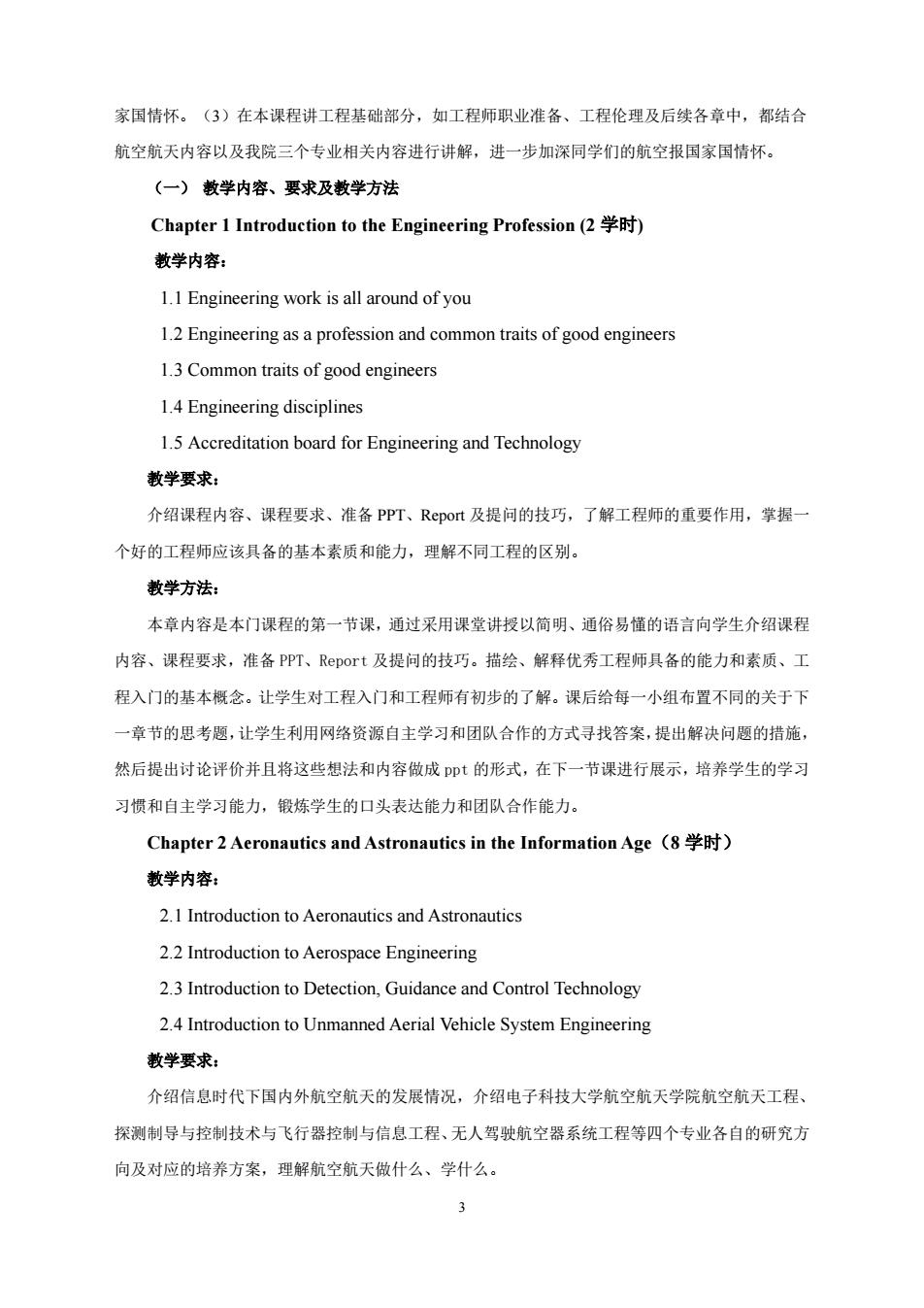
家国情怀。(3)在本课程讲工程基础部分,如工程师职业准备、工程伦理及后续各章中,都结合 航空航天内容以及我院三个专业相关内容进行讲解,进一步加深同学们的航空报国家国情怀。 (一)教学内容、要求及教学方法 Chapter 1 Introduction to the Engineering Profession(2) 教学内容: 1.1 Engineering work is all around of you 1.2 Engineering as a profession and common traits of good engineers 1.3 Common traits of good engineers 1.4 Engineering disciplines 1.5 Accreditation board for Engineering and Technology 教学要求: 介绍课程内容、课程要求、准备PPT、Report及提问的技巧,了解工程师的重要作用,掌握一 个好的工程师应该具备的基本素质和能力,理解不同工程的区别。 教学方法: 本章内容是本门课程的第一节课,通过采用课堂讲授以简明、通俗易懂的语言向学生介绍课程 内容、课程要求,准备PPT、Report及提问的技巧。描绘、解释优秀工程师具备的能力和素质、工 程入门的基本概念。让学生对工程入门和工程师有初步的了解。课后给每一小组布置不同的关于下 一章节的思考题,让学生利用网络资源自主学习和团队合作的方式寻找答案,提出解决问题的措施, 然后提出讨论评价并且将这些想法和内容做成p即t的形式,在下一节课进行展示,培养学生的学习 习惯和自主学习能力,锻炼学生的口头表达能力和团队合作能力。 Chapter 2 Aeronautics and Astronautics in the Information Age (8) 教学内容: 2.1 Introduction to Aeronautics and Astronautics 2.2 Introduction to Aerospace Engineering 2.3 Introduction to Detection,Guidance and Control Technology 2.4 Introduction to Unmanned Aerial Vehicle System Engineering 教学要求: 介绍信息时代下国内外航空航天的发展情况,介绍电子科技大学航空航天学院航空航天工程、 探测制导与控制技术与飞行器控制与信息工程、无人驾驶航空器系统工程等四个专业各自的研究方 向及对应的培养方案,理解航空航天做什么、学什么
3 家国情怀。(3)在本课程讲工程基础部分,如工程师职业准备、工程伦理及后续各章中,都结合 航空航天内容以及我院三个专业相关内容进行讲解,进一步加深同学们的航空报国家国情怀。 (一) 教学内容、要求及教学方法 Chapter 1 Introduction to the Engineering Profession (2 学时) 教学内容: 1.1 Engineering work is all around of you 1.2 Engineering as a profession and common traits of good engineers 1.3 Common traits of good engineers 1.4 Engineering disciplines 1.5 Accreditation board for Engineering and Technology 教学要求: 介绍课程内容、课程要求、准备 PPT、Report 及提问的技巧,了解工程师的重要作用,掌握一 个好的工程师应该具备的基本素质和能力,理解不同工程的区别。 教学方法: 本章内容是本门课程的第一节课,通过采用课堂讲授以简明、通俗易懂的语言向学生介绍课程 内容、课程要求,准备 PPT、Report 及提问的技巧。描绘、解释优秀工程师具备的能力和素质、工 程入门的基本概念。让学生对工程入门和工程师有初步的了解。课后给每一小组布置不同的关于下 一章节的思考题,让学生利用网络资源自主学习和团队合作的方式寻找答案,提出解决问题的措施, 然后提出讨论评价并且将这些想法和内容做成 ppt 的形式,在下一节课进行展示,培养学生的学习 习惯和自主学习能力,锻炼学生的口头表达能力和团队合作能力。 Chapter 2 Aeronautics and Astronautics in the Information Age(8 学时) 教学内容: 2.1 Introduction to Aeronautics and Astronautics 2.2 Introduction to Aerospace Engineering 2.3 Introduction to Detection, Guidance and Control Technology 2.4 Introduction to Unmanned Aerial Vehicle System Engineering 教学要求: 介绍信息时代下国内外航空航天的发展情况,介绍电子科技大学航空航天学院航空航天工程、 探测制导与控制技术与飞行器控制与信息工程、无人驾驶航空器系统工程等四个专业各自的研究方 向及对应的培养方案,理解航空航天做什么、学什么
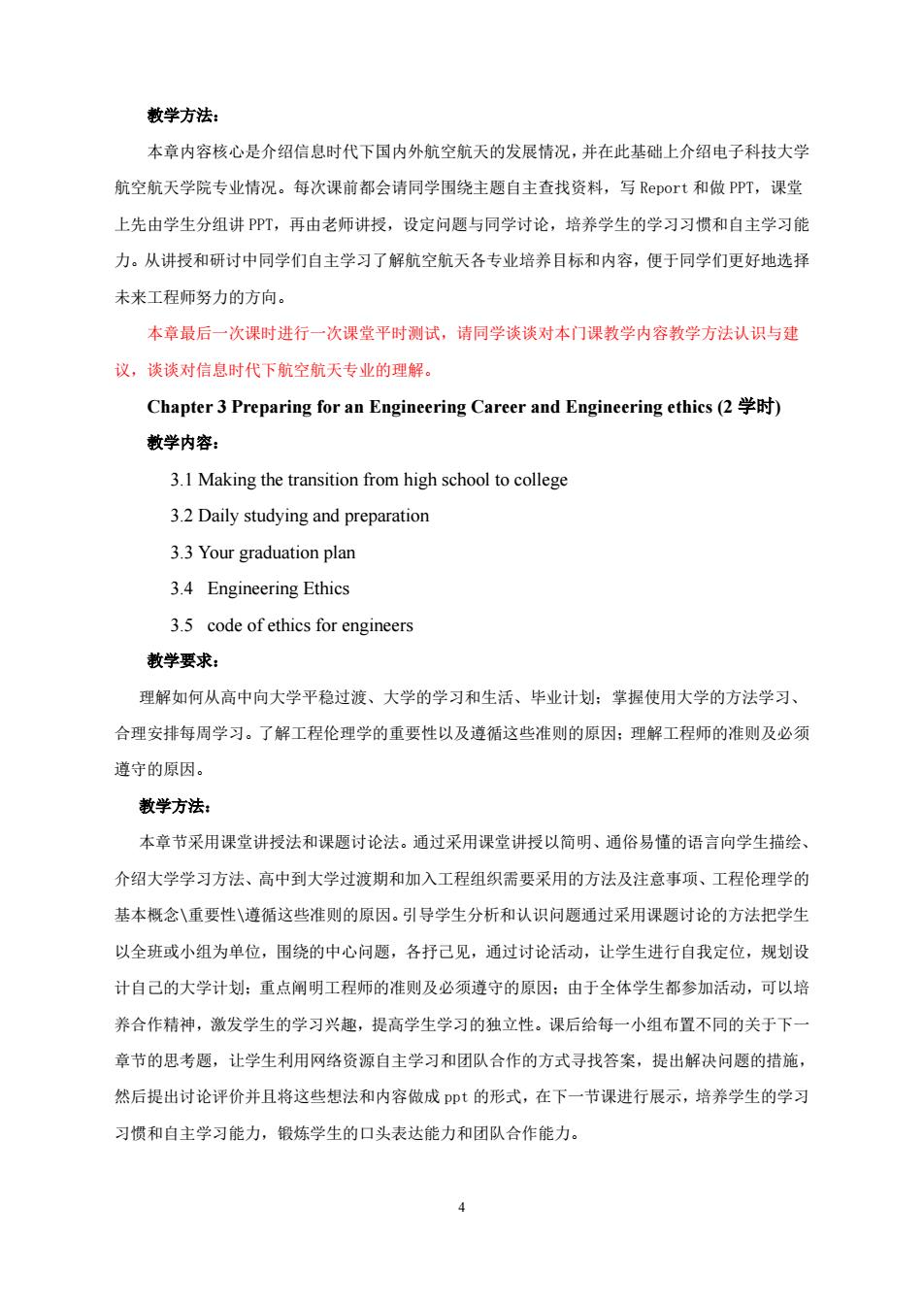
教学方法: 本章内容核心是介绍信息时代下国内外航空航天的发展情况,并在此基础上介绍电子科技大学 航空航天学院专业情况。每次课前都会请同学围绕主题自主查找资料,写Report和做PPT,课堂 上先由学生分组讲PPT,再由老师讲授,设定问题与同学讨论,培养学生的学习习惯和自主学习能 力。从讲授和研讨中同学们自主学习了解航空航天各专业培养目标和内容,便于同学们更好地选择 未来工程师努力的方向。 本章最后一次课时进行一次课堂平时测试,请同学谈谈对本门课教学内容教学方法认识与建 议,谈谈对信息时代下航空航天专业的理解。 Chapter 3 Preparing for an Engineering Career and Engineering ethics(2) 教学内容: 3.1 Making the transition from high school to college 3.2 Daily studying and preparation 3.3 Your graduation plan 3.4 Engineering Ethics 3.5 code of ethics for engineers 教学要求: 理解如何从高中向大学平稳过渡、大学的学习和生活、毕业计划:掌握使用大学的方法学习、 合理安排每周学习。了解工程伦理学的重要性以及遵循这些准则的原因:理解工程师的准则及必须 遵守的原因。 教学方法: 本章节采用课堂讲授法和课题讨论法。通过采用课堂讲授以简明、通俗易懂的语言向学生描绘 介绍大学学习方法、高中到大学过渡期和加入工程组织需要采用的方法及注意事项、工程伦理学的 基本概念\重要性遵循这些准则的原因。引导学生分析和认识问题通过采用课题讨论的方法把学生 以全班或小组为单位,围绕的中心问题,各抒己见,通过讨论活动,让学生进行自我定位,规划设 计自己的大学计划:重点阐明工程师的准则及必须遵守的原因:由于全体学生都参加活动,可以培 养合作精神,激发学生的学习兴趣,提高学生学习的独立性。课后给每一小组布置不同的关于下一 章节的思考题,让学生利用网络资源自主学习和团队合作的方式寻找答案,提出解决问题的措施, 然后提出讨论评价并且将这些想法和内容做成p即t的形式,在下一节课进行展示,培养学生的学习 习惯和自主学习能力,锻炼学生的口头表达能力和团队合作能力
4 教学方法: 本章内容核心是介绍信息时代下国内外航空航天的发展情况,并在此基础上介绍电子科技大学 航空航天学院专业情况。每次课前都会请同学围绕主题自主查找资料,写 Report 和做 PPT,课堂 上先由学生分组讲 PPT,再由老师讲授,设定问题与同学讨论,培养学生的学习习惯和自主学习能 力。从讲授和研讨中同学们自主学习了解航空航天各专业培养目标和内容,便于同学们更好地选择 未来工程师努力的方向。 本章最后一次课时进行一次课堂平时测试,请同学谈谈对本门课教学内容教学方法认识与建 议,谈谈对信息时代下航空航天专业的理解。 Chapter 3 Preparing for an Engineering Career and Engineering ethics (2 学时) 教学内容: 3.1 Making the transition from high school to college 3.2 Daily studying and preparation 3.3 Your graduation plan 3.4 Engineering Ethics 3.5 code of ethics for engineers 教学要求: 理解如何从高中向大学平稳过渡、大学的学习和生活、毕业计划;掌握使用大学的方法学习、 合理安排每周学习。了解工程伦理学的重要性以及遵循这些准则的原因;理解工程师的准则及必须 遵守的原因。 教学方法: 本章节采用课堂讲授法和课题讨论法。通过采用课堂讲授以简明、通俗易懂的语言向学生描绘、 介绍大学学习方法、高中到大学过渡期和加入工程组织需要采用的方法及注意事项、工程伦理学的 基本概念\重要性\遵循这些准则的原因。引导学生分析和认识问题通过采用课题讨论的方法把学生 以全班或小组为单位,围绕的中心问题,各抒己见,通过讨论活动,让学生进行自我定位,规划设 计自己的大学计划;重点阐明工程师的准则及必须遵守的原因;由于全体学生都参加活动,可以培 养合作精神,激发学生的学习兴趣,提高学生学习的独立性。课后给每一小组布置不同的关于下一 章节的思考题,让学生利用网络资源自主学习和团队合作的方式寻找答案,提出解决问题的措施, 然后提出讨论评价并且将这些想法和内容做成 ppt 的形式,在下一节课进行展示,培养学生的学习 习惯和自主学习能力,锻炼学生的口头表达能力和团队合作能力
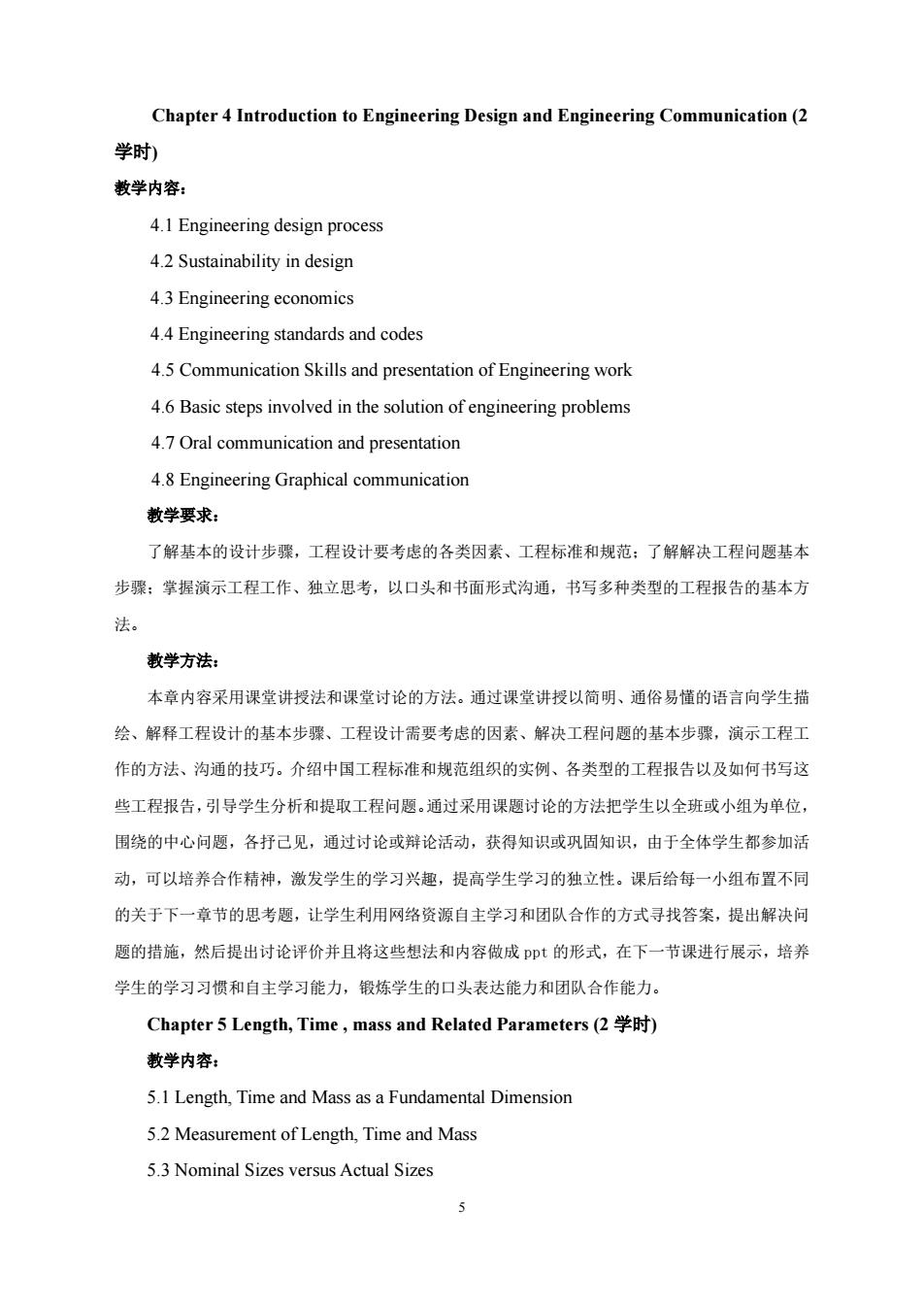
Chapter 4 Introduction to Engineering Design and Engineering Communication(2 学时) 教学内容: 4.1 Engineering design process 4.2 Sustainability in design 4.3 Engineering economics 4.4 Engineering standards and codes 4.5 Communication Skills and presentation of Engineering work 4.6 Basic steps involved in the solution of engineering problems 4.7 Oral communication and presentation 4.8 Engineering Graphical communication 教学要求: 了解基本的设计步骤,工程设计要考虑的各类因素、工程标准和规范:了解解决工程问题基本 步骤:掌握演示工程工作、独立思考,以口头和书面形式沟通,书写多种类型的工程报告的基本方 法。 教学方法: 本章内容采用课堂讲授法和课堂讨论的方法。通过课堂讲授以简明、通俗易懂的语言向学生描 绘、解释工程设计的基本步骤、工程设计需要考虑的因素、解决工程问题的基本步骤,演示工程工 作的方法、沟通的技巧。介绍中国工程标准和规范组织的实例、各类型的工程报告以及如何书写这 些工程报告,引导学生分析和提取工程问题。通过采用课题讨论的方法把学生以全班或小组为单位, 围绕的中心问题,各抒己见,通过讨论或辩论活动,获得知识或巩固知识,由于全体学生都参加活 动,可以培养合作精神,激发学生的学习兴趣,提高学生学习的独立性。课后给每一小组布置不同 的关于下一章节的思考题,让学生利用网络资源自主学习和团队合作的方式寻找答案,提出解决问 题的措施,然后提出讨论评价并且将这些想法和内容做成p即t的形式,在下一节课进行展示,培养 学生的学习习惯和自主学习能力,锻炼学生的口头表达能力和团队合作能力。 Chapter 5 Length,Time,mass and Related Parameters (2 教学内容: 5.1 Length,Time and Mass as a Fundamental Dimension 5.2 Measurement of Length,Time and Mass 5.3 Nominal Sizes versus Actual Sizes
5 Chapter 4 Introduction to Engineering Design and Engineering Communication (2 学时) 教学内容: 4.1 Engineering design process 4.2 Sustainability in design 4.3 Engineering economics 4.4 Engineering standards and codes 4.5 Communication Skills and presentation of Engineering work 4.6 Basic steps involved in the solution of engineering problems 4.7 Oral communication and presentation 4.8 Engineering Graphical communication 教学要求: 了解基本的设计步骤,工程设计要考虑的各类因素、工程标准和规范;了解解决工程问题基本 步骤;掌握演示工程工作、独立思考,以口头和书面形式沟通,书写多种类型的工程报告的基本方 法。 教学方法: 本章内容采用课堂讲授法和课堂讨论的方法。通过课堂讲授以简明、通俗易懂的语言向学生描 绘、解释工程设计的基本步骤、工程设计需要考虑的因素、解决工程问题的基本步骤,演示工程工 作的方法、沟通的技巧。介绍中国工程标准和规范组织的实例、各类型的工程报告以及如何书写这 些工程报告,引导学生分析和提取工程问题。通过采用课题讨论的方法把学生以全班或小组为单位, 围绕的中心问题,各抒己见,通过讨论或辩论活动,获得知识或巩固知识,由于全体学生都参加活 动,可以培养合作精神,激发学生的学习兴趣,提高学生学习的独立性。课后给每一小组布置不同 的关于下一章节的思考题,让学生利用网络资源自主学习和团队合作的方式寻找答案,提出解决问 题的措施,然后提出讨论评价并且将这些想法和内容做成 ppt 的形式,在下一节课进行展示,培养 学生的学习习惯和自主学习能力,锻炼学生的口头表达能力和团队合作能力。 Chapter 5 Length, Time , mass and Related Parameters (2 学时) 教学内容: 5.1 Length, Time and Mass as a Fundamental Dimension 5.2 Measurement of Length, Time and Mass 5.3 Nominal Sizes versus Actual Sizes